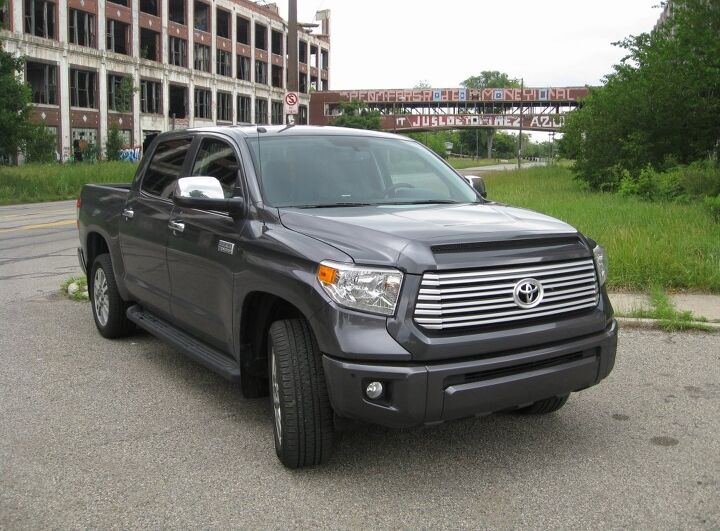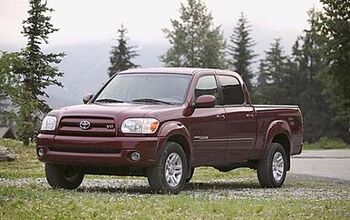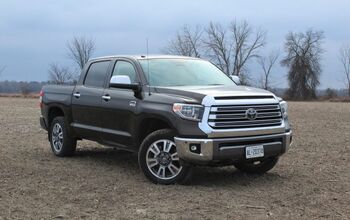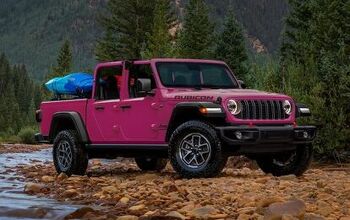2014 Toyota Tundra CrewMax Platinum 4X4 Review

It’s been said that with the last Crown Victoria produced, the death of Ford’s Panther platform represented the extinction of the species, American sedanus body-on-framus, the last of the dinosaurs. Keeping in a biological frame of mind, it seems to me that the BOF American sedan didn’t go extinct, but transformed. Its trunk developed into an open cargo bed and those varieties with high ground clearance seem to have been particularly adaptive.
That’s the closest analogy I can come up with to describe how the 2014 Toyota Tundra CrewMax Plantinum drives – it reminds me of the big American cars that were on the road when I got my driver’s license back in the early 1970s, and it should. It has body-on-frame construction, double A arm suspension up front, a live axle on leaf springs in the back, seats as flat as a sofa, and a powerful V8 engine up front, just like those old land yachts of yore. Oh, and it’s big.
Actually, that comparison somewhat disrespects the Tundra that I drove for a week. Even with the ground clearance of a pickup and the added height of a 4X4 spec’d vehicle, the Tundra handles better than any large American sedan did back in the day. I’m not saying that you should take it autocrossing, just that it goes where you point it in traffic.
Since I was driving a 4X4 pickup essentially unloaded, the fact that the ride wasn’t as smooth as my dad’s 1974 Mercury Marquis Brougham should be expected. Unloaded pickups can tend to have a bit of the bouncy bouncies. Still, it was comfortable and all that suspension travel came in handy driving on Michigan’s terrible roads. You know that you’re going over a bump, but there’s so much there to absorb it that, while you’re aware of the craters, all the crashing is happening so far away and it’s so well dampened to not even be an annoyance.
The V8 up front is a 5.7 liter engine derived from the UR family quad cam V8 first introduced in the 2006 Lexus LS460. Contrary to some urban legends, no, Toyota didn’t buy up the tooling for the old small block Chevy. The 381 horsepower motor is smooth and powerful, never lacking enough gumption to move into a spot in traffic as long as that spot was large enough.
To be honest, it took me a day or so of driving the Tundra to get used to its bulk. Because of the vagaries of press fleet scheduling, I went from one of the smallest passenger vehicles sold in North America, a Fiat Abarth, to one of the largest. How large is it? It’s barely able to fit in either a standard shopping center or urban metered parking space; I had about 6 inches to spare at each end in each case. One reason for that is it’s a true four door truck. The back seat is as spacious as anything you’d find in the biggest Lincolns or Cadillacs of the 1960s. There is enough space for three adults with ample leg room, perhaps even more room than in a long wheelbase flagship sedan like a Jaguar XJL or comparable Chinese market Audi A8. Just as one could say the American sedan has grown a trunk and ground clearance, one could say that American pickups have grown back seats. Look around you in traffic. You won’t see many simple two door pickups. Everything is either a club cab or a crew cab.
Speaking of crews, the idea that this Tundra is going to be any kind of actual work truck is dispelled by a glance at the sticker. This is a $50,000 truck and the only way that I can see it showing up on a construction site is if it’s the daily driver of the guy or gal who owns the construction or drilling company, and they ain’t gonna haul around some greasy roughnecks on the nicely quilted leather upholstery.
Concerning hauling, Toyota has heavily promoted the Tundra’s 10,000 lb. towing capacity. I believe that the owners of such blinged out Tundras will be hauling cargo, but it won’t be burly workers, room for them though there may be. No, a truck like this will use its 401 lb-ft of torque and five tons worth of towing capacity to haul things more valuable than a $50,000 pickup. One horse, let alone an entire horse trailer full of them, can exceed the Tundra’s value, as can a boat. The rest of the time the Tundra CrewMax Platinum will be used as a sedan, and that’s pretty much how I tested it. I had nothing to tow and, at 14.7 mpg over the week, I wasn’t going to drive it almost 200 miles round trip to The Mounds off-road park and back just to try out the 4X4 system.
Actually, I did get to try that out while trying to avoid a small town parade. Cutting through a parking lot I noticed what I thought was an unfinished apartment building with a driveway leading away from where the traffic was barred, so I put it in four wheel drive and took it over a curb and some vegetation, only to find out that it was an abandoned construction site and that the driveway was fenced in. Still, I got a chance to try out the 4X4, which worked fine. As it’s indeed a 4×4, not an AWD system, it’s for low speed use (and it does have a low range, too) so on pavement you’ll feel the scrubbing.
On their way to the lake, or the equestrian center, the people who buy a Plantinum trimmed Tundra will have a very comfortable experience. As you’d expect from the price, the truck had all of the latest tech toys except, oddly, no smart key, so there was no keyless entry or push-button starting. The steering wheel does swing up out of the way, the seat goes back when you’re ready to exit and, when you do leave the truck, you’ll be happy for the quite functional running boards. It’s a long way up there. That explains why the front and rear passengers have pillar mounted handles to grab for easier entry. Interestingly, Toyota must figure the driver will use the steering wheel to hoist themselves up to the commanding steering position because there’s no grab handle on that side of the cabin.
Even though you are sitting very high up, with outstanding visibility, it’s a good thing the Tundra has a parking assist system. While it won’t park the truck for you (and fie on anyone who thinks they deserve a driver’s license if they can’t parallel park), it will warn you when you’re getting close to things as ephemeral as vegetation. That particularly comes in handy because you don’t have a prayer of seeing where the offside front fender really ends. One of those camera-based, bird’s-eye views that Audi gives you would have been nice to have.
The large touch screen based infotainment system worked as well as Chrysler’s highly praised U-Connect system. My Samsung Android phone worked seamlessly and reliably in both phone and audio modes with the Toyota solution. Navigation was easy to use and never screwed up, and there are enough actual knobs for the things you want to change right now. The climate control system worked flawlessly in summer heat. I particularly like the way the “eyeball” vents on the dash can be aimed wherever you want.
I like taking 3D photos of historical sites around Detroit but one of my rules (along with avoiding taking photos of ’69 Camaros, ’57 Chevys, and perfectly restored Isetta microcars at car shows) has been to refuse to take any photos of the decrepit Packard plant on the city’s east side. I don’t do ruin porn and if I did, I’d be more creative than shooting that abandoned factory or the empty Michigan Central train station, another favorite of lazy photographers and editors. However, while I had the Tundra, it happened to be the anniversary of the end of Packard production in 1956. Some see the Packard plant as emblematic of the decline of the domestic auto industry and few vehicles represent the strength of Japanese automakers – Japan Inc. taking on Detroit Corp., if you will – than the Toyota Tundra. That’s why I decided to use the well-known overpass where unfinished Packards traveled from one section of the plant to another as a backdrop to my photos for this review.
The historical reality, of course, is that Japanese and other foreign automakers had nothing to do with Packard’s demise.
Toyota’s first dealership in the U.S. opened up in October of 1957, more than a year after the last true Packards were made in the summer of 1956. To be more precise, while the last true Packards were made in 1956, the brand name and some hideous sheetmetal were slapped on some already funny looking Studebakers following the merger of those two companies.
Toyota and other Japanese brands didn’t really get a foothold in the American market until the late 1960s. Making mostly small cars that got good gas mileage, the Japanese car companies in the U.S. market benefited from the oil crises attending the 1973 Yom Kippur war and the 1979 seizure of American diplomats in Iran. It didn’t hurt that they used some smart engineering, packaging and marketing as with the first generation Honda Accord. As the U.S. automakers seemed to go from making the standards of the automotive world to making unreliable crap in the 1980s, Toyota, Honda and Nissan became preferred brands. Then Toyota dominated everyone with their “fat engineering” Corollas and Camrys in the early 1990s.
Buoyed by the success of the Camry and Corolla with consumers in the 1990s and flush with cash, by the start of the 21st century, Toyota decided to go after the last remaining bastion of market segment dominance for the domestic car companies: full size pickup trucks.
Sure, the original Tundra was sort of a 7/8ths scale American pickup, but in 2003, when Toyota announced at the Chicago Auto Show that it was going racing in NASCAR’s truck series, it was clear that Toyota was serious about selling trucks to Americans. Then, in 2006, also at Chicago, Toyota finally introduced a genuinely full sized Tundra that competed on equal footing with GM, Ford and Dodge/Ram. To do so, the Japanese automaker made as American a truck as they could. The Tundra was engineered at Toyota’s billion dollar plus R&D center in Ann Arbor, just west of Detroit, with styling input from Toyota’s Calty facility in California. While the engine was designed in Japan, the block and heads are cast in the U.S. and, like the rest of the truck, it’s assembled here as well. The Tundra is put together at a facility in Texas built with an even larger investment than the design center in A Squared. Not coincidentally, Texas is America’s biggest pickup truck market.
When they introduced the truly fullsize Tundra about a decade ago, Toyota executives were under no illusions that they were going to get “Ford guys” or “Chevy guys” out of their trucks. Brand loyalty is about as strong as it gets with pickup truck buyers. However, at the time, Toyota made a point of how about 6% of the pickup market does shift from model year to model year based on whoever most recently introduced a redesigned truck. Those buyers tend to be businesses making dollars and cents decisions on fleets and they aren’t swayed by brand loyalty. Toyota was aiming for those buyers, hoping to expand from there. That expansion may be on the horizon. A quick check at goodcarbadcar.net shows that the Tundra’s market share for 2014 was at 5.7%, within hailing distance of that 6% baseline.
Photos by the author. You can see the full gallery here.
Ronnie Schreiber edits Cars In Depth, a realistic perspective on cars & car culture and the original 3D car site. If you found this post worthwhile, you can get a parallax view at Cars In Depth. If the 3D thing freaks you out, don’t worry, all the photo and video players in use at the site have mono options. Thanks for reading – RJS

Ronnie Schreiber edits Cars In Depth, the original 3D car site.
More by Ronnie Schreiber
Latest Car Reviews
Read moreLatest Product Reviews
Read moreRecent Comments
- Lou_BC Let me see. Humans are fallible. They can be very greedy. Politicians sell to the highest bidder. What could go wrong?
- SPPPP Vibrant color 9 times out of 10 for me. There may be a few shapes that look just right in metallic gray, for example. There are a few nices ones out there. And I like VW "White Silver". But I'd usually prefer a deep red or a vibrant metallic green. Or a bright blue.
- 28-Cars-Later Say it ain't so, so reboot #6* isn't going to change anything?[list=1][*]V4-6-8 and High "Tech" 4100.[/*][*]Front wheel drive sooooo modern.[/*][*]NOrthSTARt.[/*][*]Catera wooooo.[/*][*]ATS all the things.[/*][*]We're *are* your daddy's Tesla. [/*][/list=1]
- MaintenanceCosts Can I have the hybrid powertrains and packaging of the RAV4 Hybrid or Prime with the interior materials, design, and build quality of the Mazda?
- ToolGuy I have 2 podcasts to listen to before commenting, stop rushing my homework.















































Comments
Join the conversation
Pickup trucks get more and more absurd looking every year. The old malaise era tanks from the 1970s may have looked like rolling Gothic cathedrals with their opera windows, buttresses and vacuum actuated headlamp covers, but at least they had class.
Got my red 2015 Tundra Crewmax SR5 three months ago. Tows my RV great and has lots of room for the family and our stuff on camping trips. I can squeak well over 20mpg with it if I stay out of town, and around 12 towing. I considered a Ram Sport, but ultimately I have learned from my bad experiences with the big three and will not buy their products again.